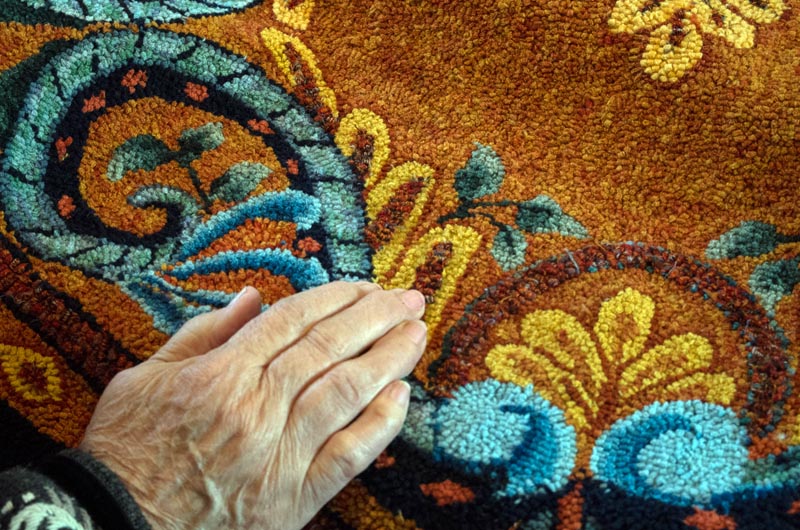Rosalie Powell is a rug hooker.
“I do it every day,” Ms. Powell, 84, said this week inside her West Tisbury studio.
Rug hooking is a 19th century art that takes patience, precision and dedication, Ms. Powell said. She worked on her first rug when she was eight years old. Her mother, Bernice Mayhew Humphreys, taught her to hook rugs in an effort to get her daughter to enter a hooked chair seat in a 4-H exhibit on the Island.
Since then, Ms. Powell has hooked 80 rugs to date, some of which are framed and hang on the walls inside her home. She has also made brick covers and pillow cases, stitched wool through canvas to create holiday scenes, flowers, scallop shells, butterflies, birds, bunnies and sheep.
She has even taken home the top prize at the national rug hooking championships three times. This year she entered Paisley Hex in the Celebration of Hand-Hooked Rugs XXIV competition. The rug has six sides and features multi-shaded flowers and scrolls made with dip dyes and spot dyes. In August she was notified that Paisley Hex had won.
“It may not mean anything to anyone that I won an award, but to rug hookers it’s a huge prize, like a Pulitzer,” said Ms. Powell.
Ms. Powell is also passionate about passing along the art. She began teaching rug hooking in 1970 when she decided to integrate it into her curriculum as the Dukes County extension service home economist, a job she began in 1964 and held for 18 years. In that role, she taught “anything from furniture refinishing and caning chairs to preserving and canning tomatoes.”
In 1984 she started another career, opening her West Tisbury home up to the public as a bed and breakfast, calling it the Bayberry Inn. She ran the business for 35 years.
“Eventually I wanted to stop making beds and just make rugs,” she said.
Ms. Powell began leading rug hooking classes again inside her home studio, an octagon shaped room with long windows and a dozens of chairs and stools fanned out around the room in a circle. She teaches everyone from beginners to what she calls rug hooking alumni, the veterans of her class.
“Everyone starts as a beginner. And then they learn the process, which has many steps.”
Each rug starts as separate pieces of wool which are then dyed and stripped into pieces as thin as 1/16 of an inch using a steel cutter. Once cut, the strips are tied onto a swatch. From there, a backing, typically made of linen or burlap, is used as a base, and a design is created much like an outline in a child’s coloring book.
Similar to cross-stitch embroidery, the foundation is attached to a frame to keep it in place for the hooking. Using a small wooden hook no bigger than Ms. Powell’s hand, the strips are woven into the foundation, creating little loops that result in a picture.
“Like quilting, rug hooking is making a comeback,” Ms. Powell said.And her favorite rugs? Ms. Powell describes a rug she created in 2011, that includes a carrot and an artichoke in the design.
“For this one I looked at pictures in a seed catalogue to trace the base,” she said. “I had an idea of what I wanted it to look like but when it came to color, I had to think more about it. The artichoke stem is green, but how green? Dark green? Light green?”
Another rug, Welcome to Martha’s Vineyard Island, shows a stitched picture of the Island with lobsters surrounding it. She finished it last year.
“My granddaughter married a Larsen and so of course I put lobsters on there. Everyone can do this map of Martha’s Vineyard, but it’s up to each person to make it their own.
“You know, I’ve had three separate careers,” Ms. Powell reflected. “One teaching, one inn keeping and one rug hooking.”
On a recent afternoon, she rested her hands on a pile of wool strips as she prepared for her next class.
“I really just love to teach and hook rugs,” she said.





Comments (4)
Comments
Comment policy »